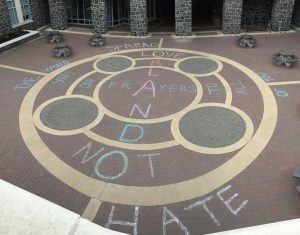How 3 college media groups localized the national conversation about Orlando
The mass shooting in Orlando on June 12 caused an immediate national reaction, adding to an already intense conversation about LGBTQ+ issues in the United States. College media organizations have not just kept up with this national event—they’ve added valuable points to the discussion.
Here’s how three college organizations across the country have covered the aftermath of the tragedy.
The Breeze
The Breeze, James Madison University’s student-run newspaper located in Harrisonburg, Virginia, took the Orlando coverage another step. Rather than simply writing about the event, writer Jo Trombadore penned “The man behind the mural,” profiling a student who created artwork in response to the tragedy.
The piece is a follow-up to The Breeze’s original coverage, which consisted of a photo slideshow and brief explanation of the mural in a university courtyard. The second piece was a great decision; by finding and interviewing the artist, the staff was able to add new depth to the story, sharing the artist’s message with readers.
Reading the article provides an intriguing look into the mind behind the courtyard artwork. Trombadore effectively detailed the artist’s dedication through her portrayal of the story—that he trekked to Wal-Mart in the middle of the night and worked on the piece until 6 a.m.
It’s articles like these that individualize national stories, transforming unknown activists into people readers can connect with on an emotional level.
The Triangle
— The Triangle (@TheTriangle) June 27, 2016
Drexel University’s The Triangle combined two Philadelphia vigils into one longer feature after the shooting in Orlando. Though the two events were a week apart, the combination of both allowed more voices to be expressed within one article. From the story, it was clear how popular and diverse the two vigils were—and the emotional quotes were well-chosen.
The writer, Walker Alexander, helped readers visualize the events by using sharp, colorful photos and descriptive language. Alexander tied in a national speech toward the end of the article, comparing President Barack Obama’s words with those of a vigil attendee. He included factual details with colorful expression, all with a focus on Philadelphia’s reaction to the shooting.
The Temple News
'I don't feel safe anymore'
Students and staff held a vigil for #Orlando victims. https://t.co/r2i4zYtpFx pic.twitter.com/Kd3vXbunYy— The Temple News (@TheTempleNews) June 25, 2016
Another Philadelphia student news source, The Temple News from Temple University, highlighted the emotional notes of the university’s vigil. Using a strong, to-the-point quote as the headline and kicker proved to be a smart choice for the article; it matched the somber tone present throughout the piece.
Photographer Brianna Spause’s striking photo added an important visual element to the story, and writer Ayah Alkhars did an excellent job of capturing the mood at the vigil—especially with sentences like, “Her words relaxed the crowd: crossed arms opened, shoulders relaxed and people stepped closer.”
Linking to The Temple News’ coverage of the city’s vigil, Alkhars focused entirely on the event hosted by the school. The article was innately localized, with meaningful quotes from students and staff members. Even from an outside perspective, the article felt personalized to the university.
How has your school covered national events? Tweet us a link to your coverage @acpress.
